This publication describes an activity conducted by the Wisconsin Department of Public Instruction to refine and pilot a set of planning tools that can be used to improve access of all students, including low-performing students with disabilities, to grade-level content. Wisconsin conducted this work as part of the Multi-state GSEG Consortium Toward a Defensible AA-MAS.
Background Information
Federal regulations require that all students participate in the accountability system. Most students with disabilities participate in the regular test with or without accommodations. A few students with the most significant cognitive disabilities participate in the alternate assessment based on alternate achievement standards (AA-AAS). In 2007, federal regulations gave state departments of education the option of developing an alternate assessment based on modified achievement standards (AA-MAS) for low performing students with disabilities.
The Wisconsin Department of Public Instruction sought to learn more about the characteristics of students who might potentially be candidates for an AA-MAS if the state offered the option (Berndt & Ebben, 2008). In 2008 and 2009, the Department held three focus groups with general and special educators, school administrators, parents, and other stakeholders. The focus group participants identified commonly held misperceptions about who could participate in an AA-MAS, and recognized that many low performing students with disabilities may not have had access to grade-level instruction. As a result of these focus groups, the Department identified a need for further professional development (Berndt, Ebben, Kubinski, Sim, Liu, Lazarus, Thurlow, & Christensen, 2011). These tools were developed to help address this need.
As part of this project, teams from Wisconsin school districts in two Cooperative Education Service Agencies (CESAs) met for two days in September 2011 to explore the area of differentiated instruction. At the workshop an expert on inclusive education (Paula Kluth) presented on differentiated instruction. Workshop attendees used the Focused Approach Planning Guide to develop a better understanding of their current practices and to identify next steps in designing a plan for implementing one or more of the ideas from the workshop in their school or district.
Follow-up interviews and surveys were conducted with CESA staff and the school/district teams. The purpose of the interviews and surveys was to learn more about how the teams were recruited, why the team members chose differentiated instruction as the area to explore, and how the planning guide helped their organizations improve access for all students. A question was also asked about recommendations for future workshops. Representative responses are presented in Appendix A.
The guide was originally developed by Dr. Alison Ford as an Action Planning Process Guide for Wisconsin’s annual State-wide Institute on Best Practices in Inclusive Education. The original guide was revised by Dr. Kim Beloin for use with the school teams who attended the Improving Student Access to Academic Content conferences that were held throughout the state of Wisconsin in 2011 and 2012.
The tools in the planning guide can be used by other schools and districts with teams of educators in a workshop setting for school improvement efforts. The workshop could open with presentations on relevant topics (i.e., using data, differentiated instruction, accommodations). Each team then could use the tools in the Focused Approach Planning Guide to move their school or district forward. The planning tools can also be used for planning by individual educators.
Top of Page |
Table of Contents
The Tools
The Focused Approach Planning Guide is presented in Appendix B. Each of the six planning tools in the planning guide is described below. We recommend that these tools are used in the order in which they are presented in the guide. The first four tools (Share and Compare, Assess, Analyze, Review and Refine) provide valuable information needed to complete the fifth tool, Planning a Next Step. Networking is the final planning tool and it can be used at any time in the planning process.
Tool 1: Share and Compare
The Share and Compare planning tool is a simple graphic organizer that will help an educator or group of educators consider new concepts, ideas, and strategies that may effectively impact instruction and learning at any grade level. Colleagues will find different concepts and strategies to be useful. This planning tool helps them come together to share their ideas and to consider the implications of using these ideas to improve education at all levels.
Tool 1 Directions. This planning tool is designed to capture key concepts, information, and strategies learned from the expertise of collegial presenters. During the workshop presentations, in the boxes on the left side of this graphic organizer, session participants should jot down the key concepts, critical information, or effective strategies that have relevance for use with a specific student, classroom, content area, school building, or school district. At the end of the presentation, participants should get together as a content-area team, grade-level team, school-based team, district leadership team, or even as an individual educator, and consider the implications of using the information gathered in the tool (in the boxes on the left) for your student(s), parents, school-based community, or district-level community. Questions to consider include: How will knowing and using this information impact our learning community? Learning environment? Approach to teaching? Approach to evaluating learning?
Tool 1: Share and Compare
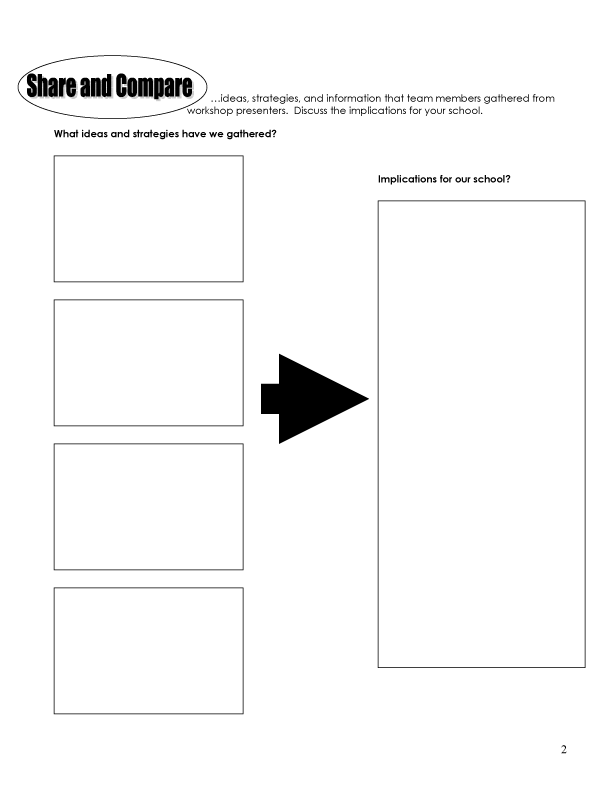
Tool 2: Assess
The Assess tool is designed to assess or evaluate current practices in the areas of effective accommodations, differentiated instruction, data-driven decision-making, and evaluation of accommodation use. The first segment is on effective accommodations. It is fairly general as it pertains to team teaching and decisions that are made amongst team teachers with regard to student accommodations. The next section of the Assess tool is on differentiated instruction. The third section focuses on data-driven decision making. This section seeks to have individuals and teams look at the data that is collected (or not collected, but needs to be collected). It also encourages purposely collecting and using data that will drive effective instructional practices. The final section is on Evaluating Accommodation Use and Decision-Making. This section enables individuals and teams to take a more detailed look into the decisions made regarding which accommodations are most effective for individual students and how those accommodations can be appropriately evaluated for future instructional decision-making.
Tool 2 Directions. The Assess planning tool provides short descriptions of typical practices in each of these areas: accommodations, differentiated instruction, and data-driven decision making. The descriptions below Column 1 list practices that are typically at a beginner stage. The descriptions under Column 2 list practices that are progressively more advanced than Level 1 practices. The practices listed under Column 3 are more advanced than Level 2 practices. Each individual or team should read through each row of Level 1-3 descriptors and assess current practices. Some professionals find that they are between Level 1 and 2 or between Level 2 and 3 practices.
Feel free to use the 1-3 scale to best show or describe your current practices for each area. Once you have assessed your current practices for each row and in each of the four overall sections, you can use the Level 2 or 3 descriptors as best practices and goals to strive toward implementing on a consistent basis. For example, if you assess your current practices at a Level 1 in a specific row or area, then your planning priority or goal for instructional improvement would be to consistently strive for the practices described in Level 2. Likewise, if you assess your current practices as a Level 2 in a specific row or area, then your planning priority or goal for instructional improvement would be to consistently strive for the practices described in Level 3.
Once you have assessed the level of your current practices, use the boxes on the right side of the page to list or briefly describe your planning priorities for the next quarter, semester, or year. Take your top four planning priorities and list them under “Summary Planning Priorities” on page 5 of the Focused Approach Planning Guide. On the right side of Page 5, decide how much time will be spent discussing, implementing, and evaluating this planning priority over the course of a quarter, semester, or academic year. There is space at the bottom of this page for any additional and critical notes that are important to keep track of throughout the Assess process. For example, key stakeholders could be listed who need to be involved in this on-going process or need to be informed of progress that is made in each of the areas of Accommodations, Differentiated Instruction, and/or Data-Drive Decision-Making.
Tool 2: Assess
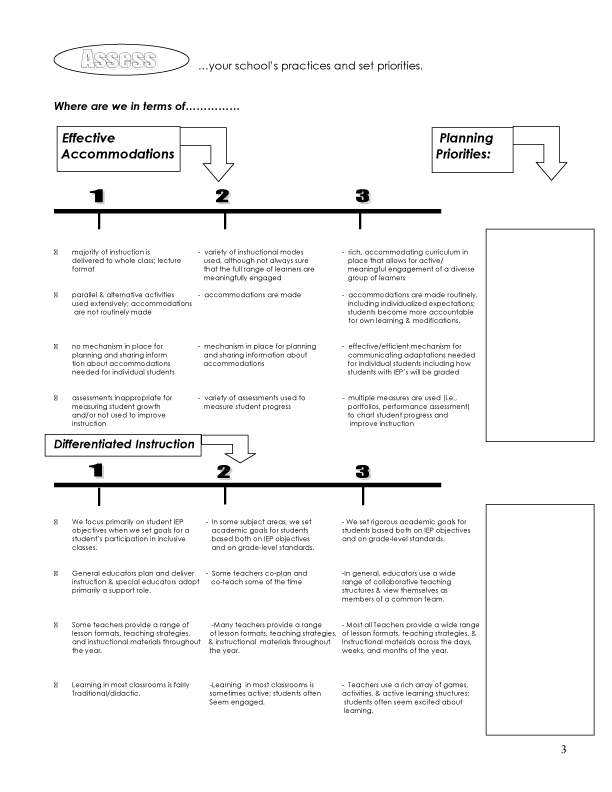
Tool 3: Analyze
The Analyze tool is designed to analyze how a team, school, or district is managing forward progress as it relates to improving student access to academic content. This planning tool challenges users to look at the critical components (e.g., vision, skills, incentives, resources, focused plan) that are needed for forward progress to occur in instructional and evaluative practices.
Vision refers to having a clearly articulated and written vision statement in place. Skills refer to having instructional staff who are skilled in the areas in which they are expected to teach or work. Incentives refer to a range of items including, recognition, encouragement, planning time, materials, and money. Resources refer to space, equipment, adequate staffing, curriculum, materials, and so on. Finally, a Focused Plan refers to having a clearly articulated and written focused plan of action that involves, and is communicated to, all stakeholders.
The Analyze framework that this tool uses was developed to enable individuals and teams to take a close look at the components that are in place and to identify those that are missing. The purpose is to remove barriers and expedite forward progress by minimizing anxiety, confusion, frustration, and false starts.
Tool 3 Directions. The first row across the top lists all five components: vision, skills, incentives, resources, and focused plan. When all components are in place, forward progress is being made on your planning priorities. The second row shows what occurs when the vision is missing, but the skills, incentives, resources, and a focused plan are in place. When the vision component is missing, this leads to confusion. Row three shows what happens if the skills are missing, but the vision, incentives, resources, and a focused plan are all in place. When skills are missing, the result is anxiety. The fourth row shows what happens when the incentives are missing, but the vision, skills, resources, and a focused plan are all in place. Without incentives, progress will occur, but it was be slow. Row five shows what occurs when resources are missing, but a vision, skills, incentives, and a focused plan are all in place. Missing resources can lead to frustration. The last row shows that if a focused plan is missing, but vision, skills, incentives, and resources are all in place, that false starts occur. The individual or team will keep starting over and over, and will not be able to make progress. Time and energy will be used up by these false starts. Consequently, all five components must be in place in order for steady forward progress to occur.
Once the analysis has taken place and the missing component(s) have been identified, the planning priorities, as indicated by the missing components, can be delineated. Step two of this tool asks you to list the planning priorities with regard to the component or components which are currently missing and in need of being developed. For example, do you need to develop and communicate a clear vision? Do you need to hire or re-allocate staff in order to have the skills in place to develop and implement a focused plan? Decide on the planning priorities based on the components that are in place and those that are missing.
Step three of this tool focuses on the identification of specific resources and incentives that are missing or that could be added in order to speed up progress.
Tool 3: Analyze
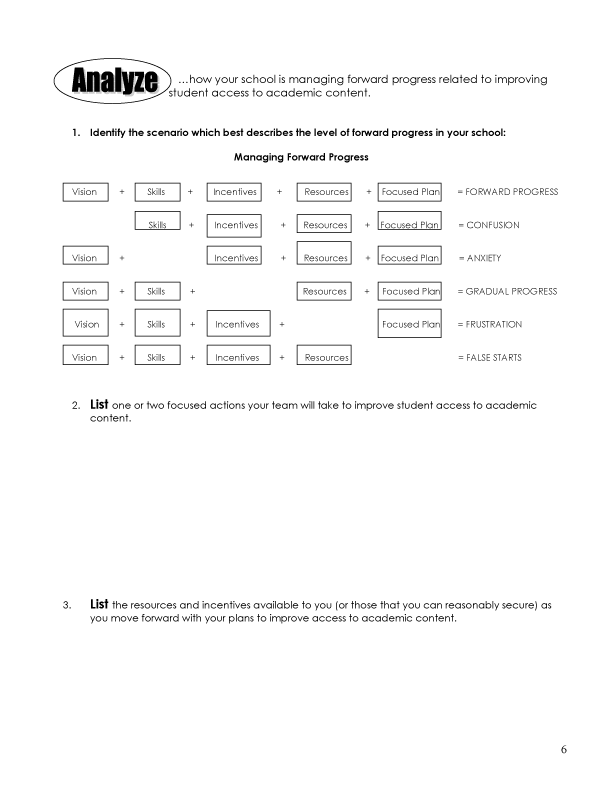
Tool 4: Review & Refine
The Review and Refine tool provides a means of collecting and using information for making changes that will help staff more effectively in provide access to academic content. This tool is used to get a clearer picture of the factors that are helping or hindering student access to academic content. The purpose of this tool is to review the current instructional practices and decisions that have guided instruction and evaluation. This tool is also referred to as the “Continue-Stop-Start” tool. It is based on the original work of Douglas Fleming and Barbara Fleming (Fleming & Fleming, nd)
Tool 4 Directions. Practices, ideas, and decisions should be listed in the left column under the corresponding headings of data-driven decision-making, differentiated instruction, or effective accommodations. Once the current practices have been listed, the individual or team should review each instructional practice, belief, or decision to discern which ones should be continued because they are effective, which should be stopped because data has shown that they are ineffective, and which new practices, beliefs, and ideas should be started because they show promise. Under the “continue” column, describe each of these practices, beliefs, or ideas that the individual or teams decides should be continued. Under the “stop” column, describe each of these practices, beliefs, or ideas should be stopped because they are not working well. Under the “start” column, describe each of these practices, beliefs, or ideas that show promise and should be started or tried.
The process utilized by this tool is meant to be an ongoing cyclical system by which new ideas, beliefs, and strategies are continually reviewed and refined. Once a new initiative is identified, discuss and describe what you are aiming to accomplish by implementing this initiative. Then, implement the new initiative for a pre-determined length of time. Next, review the data or evidence you have collected to show that this initiative did or did not work effectively. Be sure to use data to drive your decision-making and to review the initiative. Then, based on the evidence, determine which practices you should continue to implement, which should be stopped, and if any new ideas, strategies, or initiatives should be started.
This planning tool utilizes one approach to strategic and reflective inquiry with regard to instructional decision-making. Page 8 of the Planning Guide shows another set of considerations that could be used to discern effective educational practices. You may choose to use either set as you work toward reviewing and refining your current educational practices. The alternate guiding considerations are: (1) This is what we assumed would work; (2) This is what we learned; and, (3) Here is what we will do based on what we learned. These considerations accomplish the same goal of reviewing and refining educational practice.
Tool 4: Review & Refine
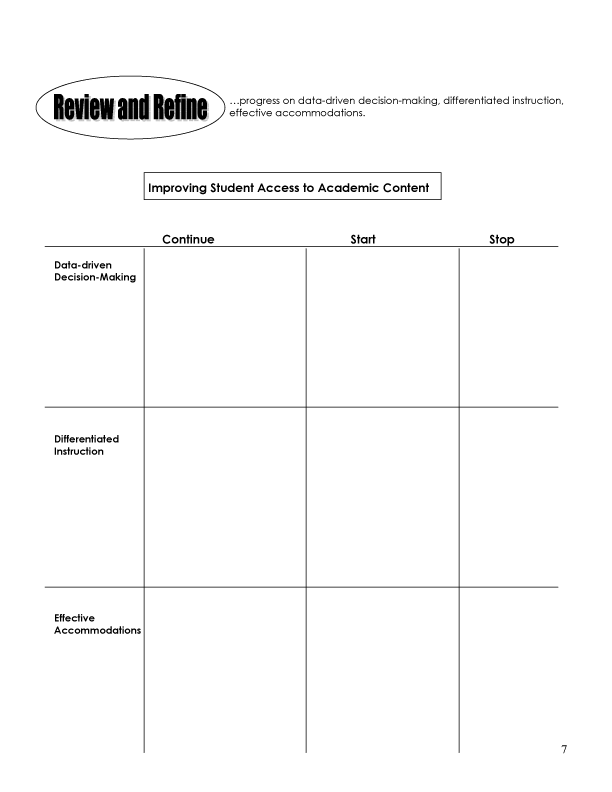
Tool 5: Plan a Next Step
The Plan a Next Step tool is the most comprehensive tool in the set, and is designed to pull the information from all of the previous tools together in order to develop a comprehensive plan for implementation. Some of the information entered on the previous planning tools is requested on this tool.
Tool 5 Directions. The first step is to describe “What is Next.” This is the information you already determined when you set your planning priorities. You also may have incorporated some new ideas and strategies that have been presented and learned.
Next is a description of “Why These (Planning Priorities) Are Important.” This step is asking you to describe the critical implications of using this new information or instructional practice in your classroom, school, or district. Remember that you described some implications on Tool 1: Share and Compare.
The next step is “Here’s How it Looks Now.” Go back to Tool 2. Assess by looking at how you rated your current educational practices. Use your current practice ratings (and associated descriptors) to describe your current educational practices in each of the three areas: accommodations, differentiation, and data-driven decision-making.
Next, you will need to describe your planning priorities in more detail under the heading of “Here’s How We Want it to Look in the Future.” Remember that your planning priorities were based on stretching yourselves from your current practices in the Assess framework, into the next level of best practices in accommodations, differentiation, and data-driven decision-making.
The next step asks that you take the planning priorities and break them down further by setting short-term measurable objectives and listing those under “These are the Steps We Will Take to Get There.” For each short, measurable objective or step, decide who will take the initiative and provide the leadership needed to get this step accomplished. List that person’s name and position in this column.
Finally, set a timeline for accomplishing each of the short-term objectives or steps that will lead to the larger, measurable goal or planning priority. Using a specific timeline helps to keep individuals as well as the team accountable for making forward progress on these agreed upon planning priorities.
Tool 5: Plan a Next Step

Tool 6: Network
Educators need time to share and observe effective practices with other educators. The Network tool is designed to capture information and collegial expertise across the buildings, schools, and districts.
Tool 6 Directions. You can use this planning tool to jot down the names of new colleagues, their professional expertise, and their contact information. When your planning priorities indicate the need to look outside for additional expertise for staff development, instructional modeling, or curriculum ideas, you can refer back to the collegial expertise you have gathered on this planning tool.
Tool 6: Network
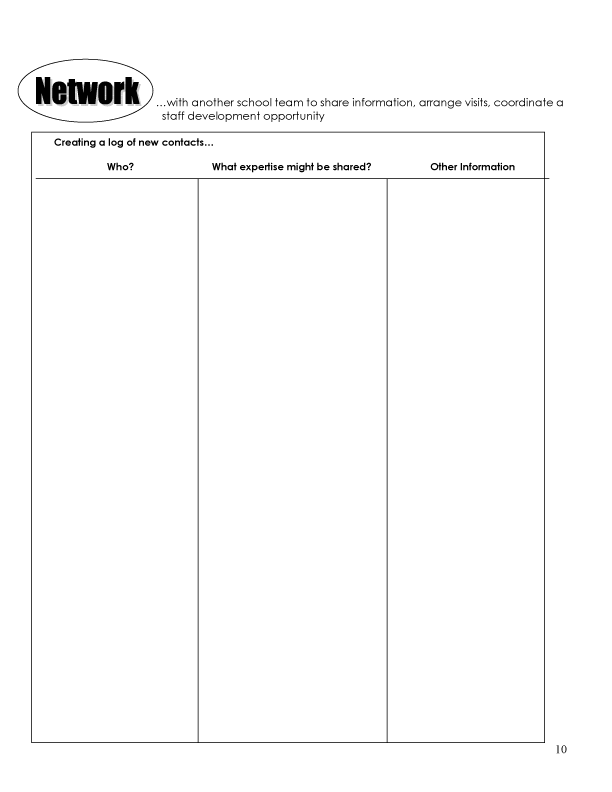
Top of Page |
Table of Contents
Conclusion
There is a need for teams of special education teachers, general education teachers, and administrators to learn ways they might work together to differentiate instruction to better meet the needs of all students, especially those students who are low performing and struggling in school.
These planning tools have been used by individual educators and education teams when planning for more effective access to academic content. The intent of this publication was to provide information about these tools so that other educators and planning teams can use them to develop plans that will lead to better access to academic content for all learners.
Top of Page |
Table of Contents
References
Berndt, S., & Ebben, B. (2008). Thinking about the students who may qualify to participate in an alternate assessment based on modified academic achievement standards (AA-MAS): A tool for study groups. Minneapolis, MN: University of Minnesota, National Center on Educational Outcomes.
Berndt, S., Ebben, B., Kubinski, E., Sim, G., Liu, K., Lazarus, S., Thurlow, M., & Christian, E. (2011). Who are the students who may qualify for an alternate assessment based on modified academic achievement standards (AA-MAS)?: Focus group results (Synthesis Report 79). Minneapolis, MN: University of Minnesota, National Center on Educational Outcomes.
Fleming, D., & Fleming, B. (no date). School strategies and options. Lunenburg MA: authors.
Top of Page |
Table of Contents
Appendix A
Follow-Up Interviews and Surveys
Table A1. Representative Responses: Follow-up Interviews with CESA Staff
- Why did CESAs’ 5 and 6 decide to offer the differentiation workshop?
- This was a topic we felt was needed in our CESA. We need to know how to make lessons accessible to all.
- We wanted to target general education teachers and assist them in learning how to change their instruction to meet the needs of all students.
- We targeted middle schools since research shows that the largest gaps in accessibility and differentiation are during the middle school years.
- What were the steps the CESAs took to recruit the school/district teams?
- We handpicked schools. Middle schools were selected that believed they would incorporate what they would learn at the conference and actually implement the ideas in their classrooms and school buildings.
- There was an open invitation to all school districts within the CESA. A personal invitation was given to select school districts which had differentiation as a school or district goal for this year.
- What support did the CESA provide their teams during the workshop?
- Provided guidance to teams by asking questions about what they heard, what were they thinking, and how they might implement differentiation practices in their schools/districts.
- Listened to team conversations and discussed next steps with them.
- Stayed with individual school teams to assist them if they had differentiation as a school/district goal.
- What has been the follow-up provided to teams since the workshop?
- Since there was no funding from the grant for follow-up, it was not possible to follow up with the school/district teams on a formal basis.
- Remained in phone contact with a few of the districts.
- Developed a WIKI application for school teams to comment on, which had limited success. It was difficult for some of the teaching teams to access the WIKI.
- Recommendations from CESAs’ 5 and 6 for additional CESA conferences.
- Tell school teams what is expected as follow-up. The brochure announcing the conference should have mentioned the planning process, team planning time, and follow-up expectations.
- Avoid scheduling the conference too early in the school year. This was difficult to do in September because it was too close to the start of the school year to develop a team that was committed to the process and follow-up.
- Require that an administrator attend with each teaching team.
|
Table A2. Representative Responses: Follow-Up Survey of Team Members
- Why did your district decide to participate in the Paula Kluth Workshop on differentiation?
- To get more ideas on how to differentiate instruction.
- Our district continues to grow with RTI as a goal. Differentiation continues to be one of the many tools that we need to continue to move in the RTI direction. The workshop description fit our needs.
- It was recommended by our CESA.
- Professional development.
- How were team participants chosen?
- I chose a middle school team because other grade levels had more exposure to differentiation conferences. It seemed like the boost that my middle school staff needed.
- All middle school staff were chosen by the principal to go,
- Our principal asked.
- The special education teachers were chosen, and then I think it was interest-based for the general education teachers. I got to go because I showed interest and wanted to go.
- During the workshop, what were some of the “aha’s” your team had?
- We really enjoyed the ideas because they were EASY to implement with little PREP time!
- How easy it is to differentiate, quick games to keep kids thinking, how to get kids up and out of their desks without chaos.
- I was very interested in how movement increases the ability to learn.
- During the workshop, which planning tools were used to assist the team in planning for follow-up activities back in the district? How were they used? How were the planning tools useful? What was not useful with regard to the planning tools?
- We used with our school group and went through the grids and filled them out together. It gave us a structure and plan to follow when we returned to school. I wish there would have been a follow-up half way through the year to keep us on track.
- We used the Plan a Next Step tool and the Network tool. All of the core teachers found a couple of activities that they could take back to the classroom and use.
- How did you use the information on differentiation and focused approach planning when you returned to the district? (Were certain students/grades targeted for interventions?)
- We started sharing our ideas through staff meetings and then used them in our rooms. Others then asked about what we were doing and wanted to follow what we were doing because it worked. The kids talked a lot about the different strategies and that’s how the word spread. I think there’s still room to do a lot more throughout the school.
- Each teacher did two or more activities in their core subject classes. They shared activities with all staff.
- We all shared with our grade-level teams various differentiation activities.
- We put on a short workshop for our staff and began regularly using the activities in our classrooms.
- How did you use the conference information on differentiation and focused planning throughout the school year?
- Incorporated many of the ideas that were shared with us.
- I’m also always thinking of the multiple ways I can teach a topic on the different learning styles.
- Implemented the strategies in our classroom.
- Information about what worked well with colleagues and they do the same.
- What are your future plans for implementing this information?
- I just want to implement more than what I’m doing this summer. I also want to get organized and plan ahead so I can include more of the ideas than I did this year. I want to keep building each year with more of the ideas and sharing what works and what doesn’t work with others.
- Will share the ideas with our staff members as we try more of them out.
- Will continue to use many of these activities in my classes. For example, have really increased movement in classes and use music as much as possible.
|
Top of Page |
Table of Contents
Appendix B
Focused Approach Planning Guide
For a "fillable PDF" click on
"Focused
Approach Planning Guide" PDF tool
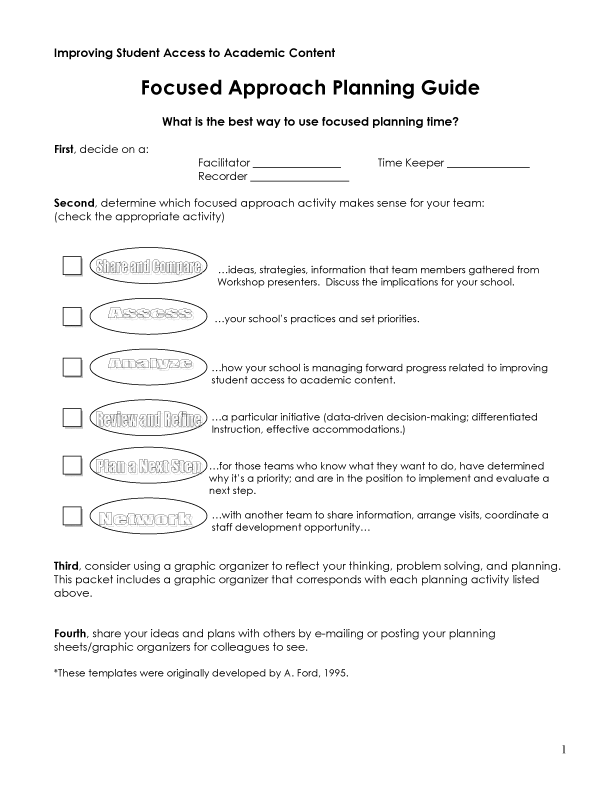


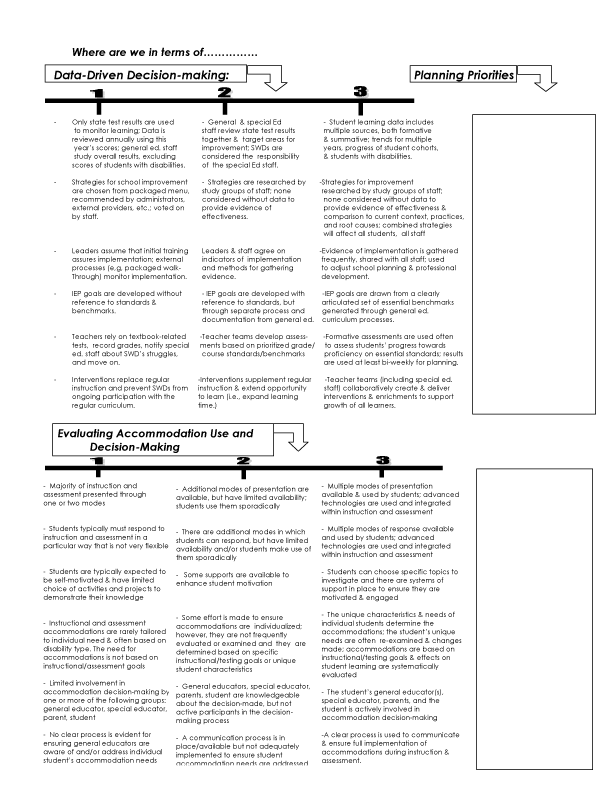
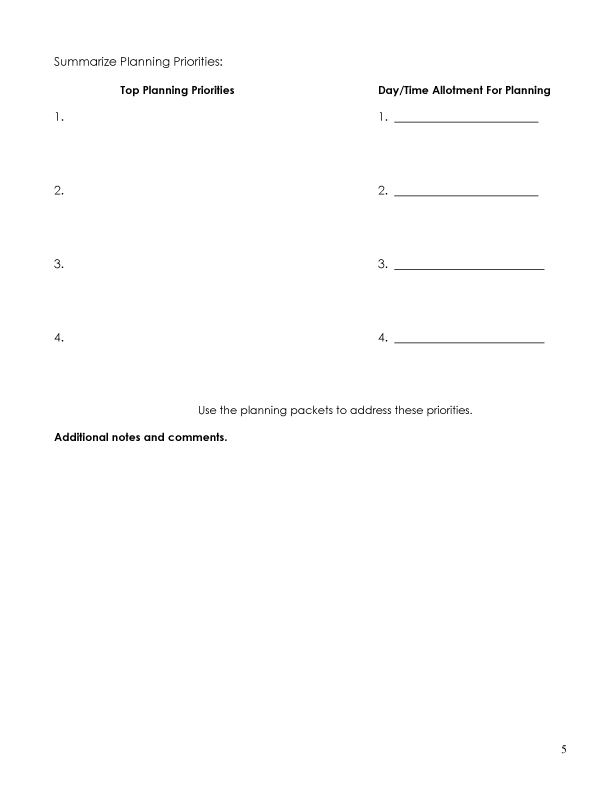


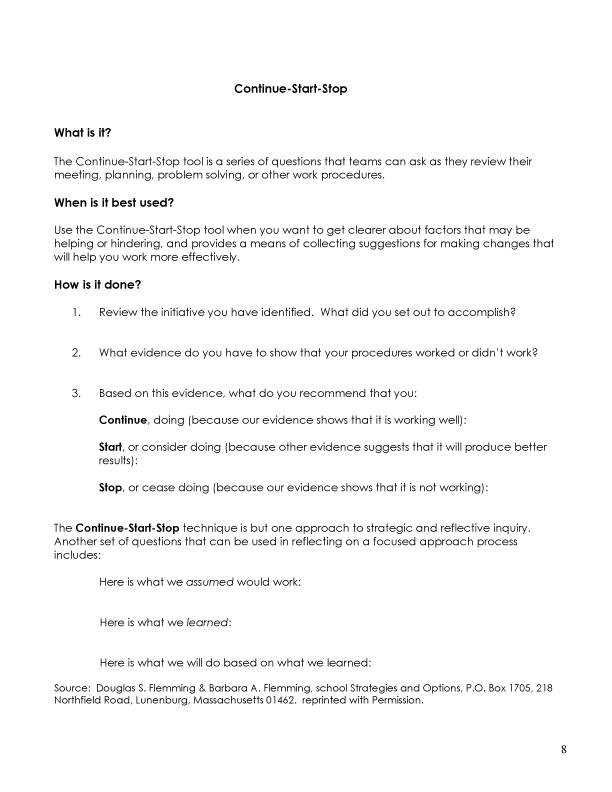


Top of Page |
Table of Contents










